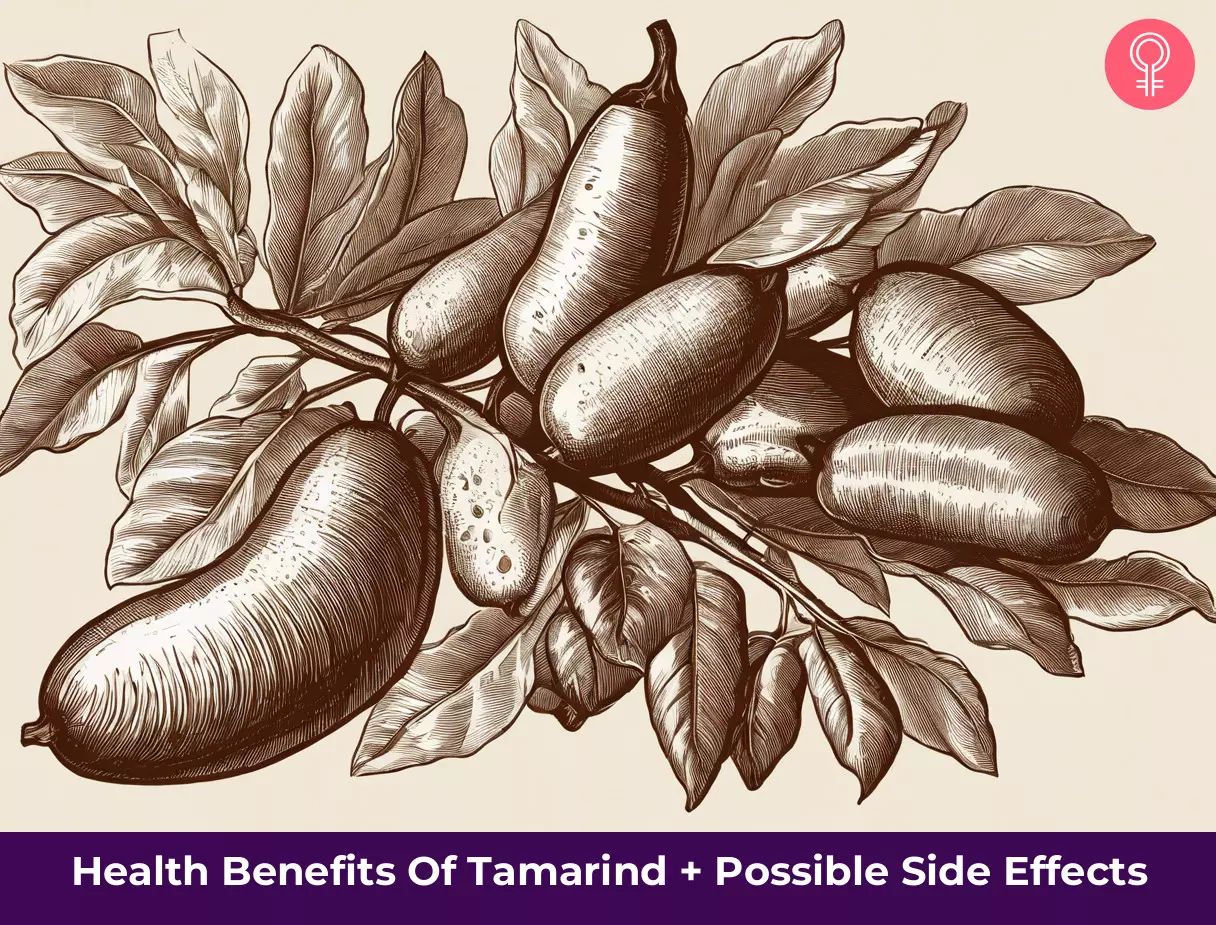Learn more about tamarind, how it can benefit you, and how to add it to your diet regimen to reap the benefits it offers from the article below. Keep reading!
What Is Tamarind?
The tamarind (Tamarindus indica) tree is native to tropical Africa. It was introduced eons ago to India. Indians adopted it so well that it became (almost) indigenous to their country. The name originates from a Persian word called tamar-I-hind (which means ‘Indian date’) (1). What Are Its Benefits? It treats constipation, moisturizes the skin, and aids in weight loss. Who Can Consume It? Anybody can consume this except people on diabetes or hypertensive medication. How Often? You can eat 10g of tamarind daily. Caution Avoid consuming this fruit if you have gallbladder stones or are pregnant or breastfeeding. Excess consumption may corrode the teeth enamel and cause acidity.
It is called ‘tamarindo’ in Spanish and Portuguese and ‘tamarin,’ ‘tamarinier,’ ‘tamarinier des Indes,’ or ‘tamarindier’ in French. It is ‘tamarinde’ in German and ‘tamarandizio’ in Italian. It is known as ‘ambli,’ ‘imli,’ ‘chinch,’ or tamarind in India. In Cambodia, it is ‘ampil’ or ‘khoua me’ and ‘ma-kharm’ in Thailand. In Vietnamese, it is just ‘me.’ It is used in various cuisines across the world, hence the several names.
Origin Of Tamarind
Tamarind is mistaken for having an Indian origin. Its botanical name, indica, also supports this myth. However, the tree was naturalized in Hawaii around 1797. Tamarind is believed to have been introduced in tropical America, Bermuda, the Bahamas, and the West Indies much earlier. Once they mature, the pods become juicy. The pulp turns brown, sticky, and fibrous. The outer skin turns into an easily cracked shell. The seeds grow hard and glossy brown. Both raw and ripe tamarind fruits are used extensively in cooking. It used as a condiment in curries, sauces, pestos, and dips. Tamarind is also cooked with rice, fish, and meat as a central ingredient in some cuisines. In other words, tamarind finds its way into almost every kitchen. But what could be the reason behind its global popularity? It can’t just be because of its taste, can it? True. Tamarind is known for its several therapeutic properties. It serves as an excellent laxative and carminative. It has potent anti-inflammatory and antiseptic properties as well. Tamarind is used traditionally for treating abdominal pain, diarrhea, dysentery, wound healing, inflammation, and fever (1). It also is believed to help in the treatment of joint pain, sore throat, asthma, swollen joints, conjunctivitisi Also referred to as pink eye, the inflammation of the eyelids and the membrane of the outer eye. , and hemorrhoidsi Rectal bleeding or discomfort due to swollen rectum veins caused by excess strain during bowel movements. . The benefits of tamarind seeds extend to skin, hair, and health. These seeds are rich in antioxidants and have anti-inflammatory properties, making them effective in promoting healthy skin and hair. The next section is all about the benefits of tamarind. Check it out!
8 Health Benefits Of Tamarind
Tamarind is a well-known home remedy for managing constipation, diabetes, skin health, and microbial infections. It is also proven to aid weight loss and prevent cardiovascular diseases. The health benefits of tamarind leaves include their ability to soothe inflammation, fight bacteria, and support overall immune function. Let’s validate these benefits of imli with some scientific evidence.
1. May Mitigate Liver Injury
Chronic inflammation in your body indirectly affects your liver. In a study, rats with arthritis were given tamarind seed extract. The results showed a reduction in liver oxidative stress (2). The active procyanidins in tamarind extract countered free radical damagei Cellular damage caused by unstable and highly reactive oxygen molecules that can lead to disease. of the liver. Depletion in the levels of inflammatory markers, like glutathione, total thiols, glutathione peroxidase, and reductase, was also noted (2), (3). The minerals found in tamarind – like copper, nickel, manganese, selenium, and iron – are involved in improving your body’s defense against oxidative stress. Selenium, along with vitamin E, protects the lipid content in liver cells from free radical attack (3).
2. Can Help Exfoliate And Lighten Your Skin
The pulp of tamarind fruit has been used as a natural skin scrub since the olden days. It promotes smoother and lighter skin because of the presence of alpha-hydroxyl acids (AHAs). The AHAs in tamarind pulp include tartaric acid (8–23.8%), lactic acid (2%), citric acid, and malic acid. These AHAs, along with pectin and inverted sugar, hydrate and moisturize your skin (4). Tamarind pulp is said to possess skin lightening properties. A study with 11 male volunteers was conducted to investigate the effect of tamarind seed extract on skin tone. The seed extract was applied/massaged twice a day on their cheeks for 12 weeks (4), (5). There was a relative decrease in skin melanin and sebum contents when the test product was applied. This could be attributed to the presence of antioxidant polyphenols in tamarind. These compounds eliminate free radicals in your body and, thus, indirectly reduce the melanin content in your skin (5).
3. May Aid Weight Management
Those looking to shed extra pounds, try tamarind for weight loss. It is an effective natural option. Obesity is linked to heart, liver, kidney, and several metabolic disorders. Researchers have studied the effect of tamarind on weight management and obesity in rat studies. Tamarind pulp was found to lower the bad cholesterol (LDL) and increase the good cholesterol (HDL) content in plasma (6). This anti-obesity effect was seen when rats on a high-fat diet received 5, 25, or 50 mg/kg of tamarind pulp extract orally for 10 weeks. This study also resulted in body weight loss in these rats (6). Moreover, this extract reduced the activity of fatty acid synthase (FAS). FAS is an enzyme that promotes the formation of adipose tissue in your body. It also prevents the oxidation of lipids by free radicals. The rat study demonstrated the antioxidant properties of this extract as well (6). The extract could induce beneficial effects in obesity-induced rats. Further studies are needed to understand what other compounds in the plant contribute to this benefit.
4. May Relieve Stomach Ache And Constipation
Tamarind has traditionally been used as a laxative because it has high amounts of malic and tartaric acids. Tamarind also contains potassium bitartrate, which, along with other active ingredients, relieves constipation (7). Constipation and diarrhea often cause abdominal pain. Tamarind bark and root extracts have been proven to be effective in curing stomach ache. In Nigeria, soaked tamarind is eaten to deal with constipation (7). Rasam is a South Indian preparation that is made of spices, tamarind, cumin, black pepper, and mustard. It is eaten with rice to promote digestion (8). Note: Although tamarind is often labeled as a laxative, its effectiveness varies depending on dosage and personal tolerance.
5. May Control Hypertension And Promote Heart Health
The dried pulp of tamarind fruits was found to have anti-hypertensive effects. Tamarind pulp has been found to reduce diastolic blood pressurei A measure of blood pressure that denotes the force exerted by the heart on the arteries in between the heartbeats. at a dose of 15 mg/kg body weight (9). Animal studies have demonstrated the anti-atherosclerotic effect of this fruit. Thus, tamarind extract has a high potential to lower the risk of atherosclerosis (clogging of arteries) in humans as well (10). The fruit extract was able to heal atherosclerotic lesionsi The structural damage and deformity caused by continued plaque build-up in and on the arterial walls. in hamsters. Moreover, active tamarind molecules possess anti-inflammatory effects. They can tone down the severity of atherosclerosis and several cardiovascular diseases (10).
6. May Help Manage Diabetes and Hyperglycemia
Tamarind brought down the blood sugar levels in diabetic rats. This fruit could neutralize hyperglycemia even in rats that had severe diabetes (10), (11). One of the major causes of diabetes is inflammation of pancreatic cells, especially those cells that produce insulin (beta cells). Since tamarind can inhibit the production of pro-inflammatory chemicals like TNF alpha, it can protect the pancreas from inflammation-induced damage (11), (12). The seeds of this fruit can boost the neogenesis (production of new cells) of pancreatic beta cells. This may restore the ability to produce required amounts of insulin in patients with diabetes (10), (12).
7. Can Help Prevent Malaria And Microbial Diseases
Tamarind has been used as a febrifuge (fever control medicine) in traditional medicine. African tribes in Ghana use the leaves of tamarind to treat malaria (10). This fruit also has a broad-spectrum of antimicrobial properties (10). Extracts of tamarind have shown significant inhibitory effect against Burkholderia pseudomallei, Klebsiella pneumoniae,Salmonella paratyphi, Bacillus subtilis, Salmonella typhi, and Staphylococcus aureus (10). Various parts of this plant have been used to treat malaria. Similar fevers caused due to bacterial infections can also be managed with tamarind extracts. Its anti-inflammatory and antioxidant properties could play a critical role in such cases.
8. May Ease Menstrual Cramps
Tamarind has remarkable anti-inflammatory and analgesic attributes that may potentially offer relief during menstruation. Its anti-inflammatory properties may help reduce the severity of menstrual cramps and bloating. Furthermore, tamarind’s analgesic properties may serve as a mild pain reliever, which may help ease menstrual cramps (13). However, these claims are not backed by scientific research. Further studies and clinical trial data are warranted to substantiate these claims. While some individuals may find it effective for managing menstrual discomfort, individual responses can vary. Consult a healthcare professional before taking tamarind or its supplements for menstrual pain management. Aren’t these benefits of tamarind amazing? Scroll down to read some other benefits of this tropical fruit! Tamarind is a household name. This sour-sweet fruit is a staple in several cuisines. Its integral place in the kitchen is because of its excellent nutritional value. Check out the next section to find out more. Its extract prevents edemai A medical condition where fluid builds up or is retained inside the body tissues, organs, and cavities, leading to abnormal swelling. , hemorrhage, and rapid blood clotting in victims. Moreover, tamarind seeds can inhibit several enzymes that are involved in venom response in your body (10). In India and Africa, tamarind is used as an aphrodisiac. Rat studies demonstrated the effect of this fruit extract on sexual drive and arousal. Male rats showed an increase in sperm count and motility. Tamarind extract has low toxicity and is safe up to an oral dose of 2000 mg/kg (14). Apart from the above mentioned benefits, the soxhlet methanolic extract presented tamarind may play a role in cancer prevention (1).
Nutritional Value of Tamarind
The values in the brackets include the daily value of the particular nutrient the serving of the ingredient meets . Mary Sabat, MS, RD, LD, says, “Tamarind is a good source of the antioxidant vitamin C and contains a range of B vitamins, including folate, niacin, pantothenic acid, riboflavin, and thiamin. It also contains minerals, such as calcium, copper, iron, magnesium, phosphorus, potassium, and zinc.” (Source: United States Department of Agriculture) Tamarind contains a variety of biologically active phytochemical compounds. Predominantly, it contains catechin, epicatechin, proanthocyanidins, apigenin, luteolin, naringenin, taxifolin, eriodictyol, and other phenolic polymers (15). Tamarind leaf pulp contains pipecolic acid, nicotinic acid, 1-malic acid, geraniol, limonene, pipecolic acid, lupanone, lupeol, orientin, isoorientin, vitexin, isovitexin, cinnamates, serine, pectin, tannins, and glycosides (7). Tamarind fruits commonly contain tannins, succinic acid, citric acid, tartaric acid, and pectin. Its seeds contain campesterol, beta-amyrin, beta-sitosterol, oleic acid, palmitic acid, linoleic acid, and eicosanoic acid. Cellulose, albuminoid amyloids, and phytohemagglutinin were also found in traces (7). Tamarind is also a good source of Vitamin A and C that play a part in producing energy and may help improve eyesight (1). The phytochemicals and nutrients of tamarind act in synergy to produce its miraculous benefits. Aren’t you excited to use tamarind in your cooking? Here are a few tips on how to use and store tamarind.
How To Use And Store Tamarind
There are various ways you can use tamarind in your cooking. One of the simplest ways to extract the pulp of this fruit is by soaking it.
Soak a small piece of tamarind in warm water. Leave it in the water for about 10 minutes until it softens. Squeeze and squish the tamarind piece with your fingers. Strain the juice and discard the pulp.
The next method takes a bit longer. You will need to soak, refrigerate, and extract the pulp.
Place a handful of semi-dried tamarind pieces in a glass container that has a lid. Pour enough drinking water to immerse the pieces. Close the lid and place the container in the refrigerator. Leave it overnight. By the next morning, the chunks of tamarind will soften and be ready to use. Squeeze sufficient pulp and store the rest of the soft tamarind. Cover the container once you are done. Let the rest remain in the refrigerator until it lasts.
Now comes the elaborate and (a little) messier way of extracting the pulp. In this method, you soak, squeeze, and boil the tamarind.
Add 5-6 ounces of tamarind pieces and 2 cups of water to a microwave-safe bowl. Heat it in the microwave for about a minute until the pieces soften. Let the contents cool down completely. Once cooled, squish out the pulp from the soaked tamarind pieces using your fingers. Add small amounts of water and keep squeezing the pulp until the yield ceases. You will have a slurry of tamarind pulp in water. Run the slurry through a mesh/sieve/strainer to collect the juice in a colander. Add more water to the remaining pulp in the sieve and squeeze it to extract the last traces of tamarind juice. You should only be left with the fiber and seeds from the fruit when you are done. Discard the solid waste and transfer the juice to a saucepan. Boil the contents for 1-2 minutes. Reduce the heat to a simmer for 5 minutes. The juice should thicken to a soupy-syrupy consistency by now. Remove from heat and let it cool completely. Pour the fresh tamarind syrup into a clean, sterile jar. Refrigerate until the next use. Use a clean, dry spoon to take out the tamarind syrup. Refrigerate the rest. Don’t leave the spoon/ladle in the bottle.
This way, tamarind extract can last up to three months. If you use tamarind in your cooking every day, the above method is probably the best. It saves you time and effort without compromising on the taste. Mary Sabat suggests a few ways to incorporate tamarind into your diet:
- Tamarind Pork: Marinate pork in a mixture of tamarind, onions, garlic, and spices and then pan-fry for a flavorful dish. 2. Tamarind Rice: Make a pilaf-style rice by sautéing onions, garlic, and ginger in ghee and then adding spices and cooked basmati rice. Finish with tamarind and fresh cilantro leaves. 3. Tamarind Chutney: Blend tamarind pulp with sugar, spices, and herbs for a sweet and tangy condiment. 4. Tamarind Soup: Simmer tamarind pulp in a broth of your choice and add vegetables and spices for a hearty soup. 5. Tamarind Glazed Salmon: Mix tamarind paste with honey, garlic, and ginger and use it to glaze a filet of salmon. Roast in the oven for a flavorful meal. Look for creative ways to use tamarind in your cooking, including marinating meats, blending with smoothies for a refreshing tangy touch, or enhancing the flavors of sauces and dressings. You can try the method you prefer and enjoy the benefits of tamarind. Including tamarind in your food can fulfill the recommended daily requirement of several minerals like iron, zinc, magnesium, and calcium. Tamarind also has medicinal uses. It could be used in the form of a beverage to treat constipation or fever. Its bark and leaves may also be used to promote wound healing. However, more research is warranted in this regard.
Different Forms Of Tamarind
There are two major forms of tamarind. The most common form is the one that tastes sour. The other form is sweet tamarind that is usually grown in Thailand. Tamarind can be consumed fresh, both in its ripe or unripe forms. It also can be processed into different products. Tamarind juice has similar benefits, as discussed in this post. Though tamarind is medicinally very relevant, excess intake can cause problems. In the following section, we will look at the possible side effects of tamarind.
Does Tamarind Have Any Side Effects Or Risks?
The World Health Organization (WHO) considers tamarind fruit to be safe and non-toxic. Rat studies have shown no mortality/toxicity even after the administration of 5000 mg/kg and 3000 mg/kg doses of its extract (16). Mary says, “People with certain medical conditions or allergies should not eat tamarind. Those with an allergy to legumes, such as peanuts or soybeans, should avoid tamarind, as the fruit is a member of the legume family. Those with diabetes should also avoid tamarind as it is high in sugar. Additionally, those with kidney or gallbladder problems should not eat tamarind, as it is a strong purgative.” Your kidneys may be affected by mineral overload. It would be better to consult a nutritionist/healthcare provider to decide on the upper limit of tamarind intake for you (16). Tamarind also has high acid content. Overconsumption can increase the acid levels in your digestive system and lead to acidity (17). There is insufficient data to understand the safety of consuming tamarind for pregnant and nursing women. Also, if you are on anti hypertensive or anti-diabetic drug medication, it is better to consume only small amounts of this fruit extract. Some may advise you against its usage. However, none of these claims have been proven. Can tamarind relieve hormonal disorders? Mary says, “Tamarind does not appear to directly affect metabolism or hormones. Therefore, it is unlikely to be effective for treating hormonal imbalance or decreasing testosterone.” Is it good to eat tamarind every day? Yes. Tamarind is rich in nutrients, and including it in your everyday diet can improve your health in the long run. Is tamarind good for sleep? Some believe that the high magnesium content in tamarind may help promote sleep. The mineral is believed to relax nerves. However, there is lack of scientific evidence to back this up. Does tamarind help treat kidney stones? There is no research that links tamarind to treating kidney stones. Excess intake of tamarind may, in fact, overload your kidneys with the minerals. Is tamarind good for migraine? There is no scientific backing to prove that tamarind can help migraines. Does tamarind cause ulcers? No. On the contrary, tamarind has been associated with a reduced risk of stomach ulcers thanks to its phenolic compounds (18). Is tamarind good for acid reflux? Possibly not. In fact, anecdotal evidence suggests that tamarind may aggravate acid reflux in susceptible individuals. Consult your doctor for more information.
Illustration: Health Benefits Of Tamarind + Possible Side Effects













